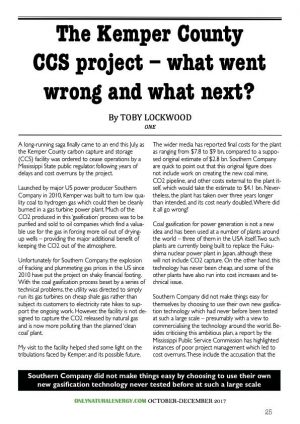 A long-running saga finally came to an end this July, as the Kemper County carbon capture and storage (CCS) facility was ordered to cease operations by a Mississippi State public regulator, following years of delays and cost overruns by the project.
A long-running saga finally came to an end this July, as the Kemper County carbon capture and storage (CCS) facility was ordered to cease operations by a Mississippi State public regulator, following years of delays and cost overruns by the project.
Launched by major US power producer Southern Company in 2010, Kemper was built to turn low quality coal to hydrogen gas which could then be cleanly burned in a gas turbine power plant. Much of the CO2 produced in this ‘gasification’ process was to be purified and sold to oil companies which find a valuable use for the gas in forcing more oil out of drying-up wells – providing the major additional benefit of keeping the CO2 out of the atmosphere.
Unfortunately for Southern Company, the explosion of fracking and plummeting gas prices in the US since 2010 have put the project on shaky financial footing. With the coal gasification process beset by a series of technical problems, the utility was directed to simply run its gas turbines on cheap shale gas rather than subject its customers to electricity rate hikes to support the ongoing work. However, the facility is not designed to capture the CO2 released by natural gas and is now more polluting than the planned ‘clean coal’ plant.
My visit to the facility helped shed some light on the tribulations faced by Kemper, and its possible future.
The wider media has reported final costs for the plant as ranging from $7.8 to $9 bn, compared to a supposed original estimate of $2.8 bn. Southern Company are quick to point out that this original figure does not include work on creating the new coal mine, CO2 pipeline, and other costs external to the plant itself, which would take the estimate to $4.1 bn. Nevertheless, the plant has taken over three years longer than intended, and its cost nearly doubled. Where did it all go wrong?
Coal gasification for power generation is not a new idea and has been used at a number of plants around the world – three of them in the USA itself. Two such plants are currently being built to replace the Fukushima nuclear power plant in Japan, although these will not include CO2 capture. On the other hand, this technology has never been cheap, and some of the other plants have also run into cost increases and technical issue.
Southern Company did not make things easy for themselves by choosing to use their own new gasification technology which had never before been tested at such a large scale – presumably with a view to commercialising the technology around the world. Besides criticising this ambitious plan, a report by the Mississippi Public Service Commission has highlighted instances of poor project management which led to cost overruns. These include the accusation that the project was rushed to meet a 2014 operational deadline required to obtain a federal tax credit, apparently leading to it still being partly designed after construction had begun.
The company may have also not paid adequate attention to tracking changes in the cost of commodities and labour. In any event, it seems clear that the original cost estimate was somewhat optimistic, and a three-year delay is bound to rack up costs for any project, in labour costs alone.
Visiting Kemper brings home the scale of the equipment that may never be used. The three acres of the plant site house a labyrinth of stainless steel piping and reaction vessels which look more like a chemical facility than a power plant. Most of this equipment now stand idle, while the two gas turbines turn quietly in one corner of the site.
Although the whole site is huge, it still seems compact relative to the alternative ‘post-combustion’ approach to carbon capture, which employs towering chemical absorbers to remove the CO2 from the flue gas produced by conventional power plants. This size reduction is thanks to the high pressures at which the Kemper process operates, which also make CO2 easier to separate and explains much of the early interest in gasification for carbon capture.
Smaller sub-plants of various colours dotted around the site are evidence of another key advantage. These facilities are designed to take sulphur and nitrogen compounds produced by the coal – usually air pollutants – and convert them to useful by-products in the form of sulphuric acid and ammonia.
Many have proposed that even the hydrogen produced by this kind of plant could be used for chemical manufacture rather than power generation, although this was not tried at Kemper.
The whole gasification and CO2 capture process was successfully tested last year, but ongoing technical issues have led to the state’s eventual loss of patience. Southern Company attributes most of these problems to standard teething issues, or unforeseeable errors by contractors. Having been sitting around for months in the open air, the coal supply had absorbed too much water and weathered into small particles, making it difficult to dry.
The heat resistant lining of the gasifier units had been poorly installed and would flake off and clog other parts of the plant – this had been scheduled for replacement. Earlier this year, some of the thin tubes designed to cool the hot gas with steam began to burst in places, apparently due to weak spots where they were welded to supports.
The company remains bullish about the viability of the plant, maintaining that all these problems were fairly easily solved and that such issues are not unusual for first examples of industrial technologies at large scale. They also point out that the plant’s reliability compared favourably with the early months of operation of other gasification technologies.
However much money has been poured into Kemper so far, it seems even more wasteful not to find some use for this pioneering facility and few doubt that it could operate reliably given a bit more time.
While the shale gas revolution may have condemned coal gasification to the history books in the US, the technology will undoubtedly still prove valuable in East Asia, where gas is expensive, and coal remains king.
An operating Kemper could send a strong global message on the viability of CCS and the strength of US commitment to the technology, and past short-comings may be sooner forgotten. Instead, it risks standing as a high-profile monument to the supposed expense and impracticality of the technology, even while other plants have proved much more successful.
Saving Kemper may be well out of reach of the President’s Office, but it is certainly ironic that such a flagship ‘clean coal’ project should fail under the watch of the pro-coal Mr. Trump.
There may yet be political salvation for the facility though. A current (pre-Trump) bill to raise an existing tax credit for every ton of CO2 stored by CCS plants from the current $22 to as high as $50 could change the game for Kemper.
To obtain the maximum reward the plant would have to pump CO2 underground without using it in oil production, but Southern Company geologists have already extensively explored this option for the plant and prospects look good. It seems unlikely, but Kemper may still be put to use for the purpose it was intended.
Toby Lockwood

